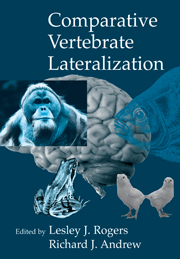Book contents
- Frontmatter
- Contents
- List of Contributors
- Preface
- Introduction
- Part one Evolution of lateralization
- Part two Development of lateralization
- Part three Cognition and lateralization
- 10 Evidence for cerebral lateralization from senses other than vision
- 11 Facing an obstacle: Lateralization of object and spatial cognition
- 12 Laterality of communicative behaviours in non-human primates: A critical analysis
- 13 Specialized processing of primate facial and vocal expressions: Evidence for cerebral asymmetries
- Part four Lateralization and memory
- Epilogue
- Author Index
- Subject Index
- Richard Andrew
10 - Evidence for cerebral lateralization from senses other than vision
Published online by Cambridge University Press: 10 December 2009
- Frontmatter
- Contents
- List of Contributors
- Preface
- Introduction
- Part one Evolution of lateralization
- Part two Development of lateralization
- Part three Cognition and lateralization
- 10 Evidence for cerebral lateralization from senses other than vision
- 11 Facing an obstacle: Lateralization of object and spatial cognition
- 12 Laterality of communicative behaviours in non-human primates: A critical analysis
- 13 Specialized processing of primate facial and vocal expressions: Evidence for cerebral asymmetries
- Part four Lateralization and memory
- Epilogue
- Author Index
- Subject Index
- Richard Andrew
Summary
A fundamental issue concerning the nature of vertebrate lateralization is the extent to which such lateralization is generated by mechanisms common to all senses. At the lowest level, there is linkage by simple physical constraints: if a bird turns its head to look at an object with the left lateral visual field, it cannot avoid also turning the left ear towards the object. Attentional mechanisms are bound also to be important: any target of interest identified by any sense will tend to become a target for all. However, there is also evidence that there is left–right specialization of perceptual processing for hearing, olfaction and touch, which resembles that which is more fully established for vision. Briefly, this specialization involves the use of mechanisms of the left side of the forebrain in the control of response to an identified target, and the use of mechanisms of the right side in analysis of a wide range of cues, including spatial relations.
Hearing
In the case of hearing, unlike that of vision, there is no possibility of inputs being initially routed exclusively to one side of the central nervous system. Sounds may reach the ears at markedly different amplitudes or times, but they nevertheless reach both ears. However, the properties of an auditory stimulus do affect lateralized processes of perception: it will be shown that perceived position of a sound affects which hemisphere is responsible for its processing.
- Type
- Chapter
- Information
- Comparative Vertebrate Lateralization , pp. 365 - 382Publisher: Cambridge University PressPrint publication year: 2002
- 8
- Cited by



